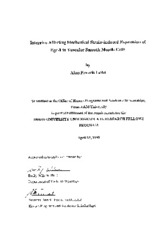| dc.creator | Lobo, Alan Francis | |
| dc.date.accessioned | 2013-02-22T20:40:14Z | |
| dc.date.available | 2013-02-22T20:40:14Z | |
| dc.date.created | 1999 | |
| dc.date.issued | 2013-02-22 | |
| dc.identifier.uri | https://hdl.handle.net/1969.1/ETD-TAMU-1999-Fellows-Thesis-L633 | |
| dc.description | Due to the character of the original source materials and the nature of batch digitization, quality control issues may be present in this document. Please report any quality issues you encounter to digital@library.tamu.edu, referencing the URI of the item. | en |
| dc.description | Includes bibliographical references (leaves 27-29). | en |
| dc.description.abstract | Integrins are transmembrane proteins that anchor cells to the extracellular matrix, ECM, and they are thought to play a very important role in the transmission of signals between the ECM and the cell. The cells of interest in this study are the vascular smooth muscle (VSM) cells, specifically the mouse aortic VSM cells, which are constantly under cyclic mechanical strain. It has been shown in previous studies that this strain induces proliferation of the cells by autocrine action of platelet derived growth factor (PDGF). The PDGF promoter contains a binding site for the transcription factor, early growth response gene-1 (Egr-1). It was previously shown that when the cell undergoes cyclic mechanical strain, Egr-1 mRNA expression is significantly increased. The scope of this study is to determine the integrins that are involved in the mechanical signaling via cyclic mechanical strain. Introducing neutralizing antibodies that block the function of the integrins and subjecting VSM cells to mechanical strain with the Flexercell strain unit may lead to the deduction of the integrins that are involved in transmitting the signal to increase Egr-1 mRNA expression. Egr-1 expression would be expected to decrease when the integrin that is transducing the strain response is blocked. The RT-PCR procedure was developed and used for determination of Egr- 1 mRNA expression through the course of this study. There are still many problems that must be assessed before the integrin may deduced. Problems in the procedure including antibody concentrations, in the handling of cells and RNA, and in the basal expression of the Egr-1 mRNA arose through the course of the study. From the latest experiment and from previous studies by Wilson et al., it is suggested that the b3 subunit and thus the anb3 integrin may be responsible for transducing the mechanical strain signal and increasing Egr-1 mRNA expression. | en |
| dc.format.medium | electronic | en |
| dc.format.mimetype | application/pdf | |
| dc.language.iso | en_US | |
| dc.publisher | Texas A&M University | |
| dc.rights | This thesis was part of a retrospective digitization project authorized by the Texas A&M University Libraries in 2008. Copyright remains vested with the author(s). It is the user's responsibility to secure permission from the copyright holder(s) for re-use of the work beyond the provision of Fair Use. | en |
| dc.subject | medical physiology. | en |
| dc.subject | Major medical physiology. | en |
| dc.title | Integrins affecting mechanical strain-induced expression of egr-1 in vascular smooth muscle cells | en |
| thesis.degree.department | medical physiology | en |
| thesis.degree.discipline | medical physiology | en |
| thesis.degree.name | Fellows Thesis | en |
| thesis.degree.level | Undergraduate | en |
| dc.type.genre | thesis | en |
| dc.type.material | text | en |
| dc.format.digitalOrigin | reformatted digital | en |


